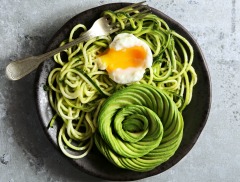Don't just meal plan... meal plan intelligently - with Meal Genius! Sign up for our free newsletter to get delicious recipes, sample meal plans and a whole lot more!
Kohlrabi
Kohlrabi, a member of the Brassica species and a crucifer, was believed to be enjoyed by the ancient Romans.
Similar to a turnip, both kohlrabi's purple-tinged, white bulb-like stem and its greens are edible.
While kohlrabi is best steamed, this cruciferous vegetable can also be chopped and added to stir-fries and soups.
Kohlrabi is an excellent source of vitamin C and provides cancer-fighting nutrients including glucoslinolates.
The Benefits
- Special diets: Autoimmune Paleo Diet, Candida Diet, Diabetic, Elimination Diet, Gluten-Free Diet, Gluten-Free/Dairy-Free Diet, Grain-Free Diet, Low Acid Diet, Low Carb Diet, Low FODMAP Diet, Low Histamine Diet, Low Oxalate Diet, Low Starch Diet, Paleo Diet (Light), Paleo Diet (Strict), PCOS Diet, Pescetarian Diet, Primal Diet, Thyroid Diet, Vegetarian Diet, Whole Food
- Excellent Source of: VitaminC
- Good Source of: Fiber, Potassium, VitaminB6
- Preferences: No Fish, No Red Meat, No Pork, No Eggs, No Shellfish, No Gluten, No Nuts, No Seeds, No Soy, No Dairy, No Poultry, No Molds, No Citrus, No Pseudograins, No Coconut, No Nightshade, No Corn, No Yeast, No Peanuts, No Legumes, No Grains, Low Carbohydrate, Low Cholesterol, Low Fat, Low Sodium, Low Sugars, Low Saturated Fat
Related Foods
Related Nutrients
Selecting and Storing
Choose kohlrabi that is heavy for its size with crisp, deep green leaves. Avoid those with soft spots or brusing on the bulb or yellow leaf tips. Store kohlrabi tightly wrapped up to 4 days in the refrigerator.









